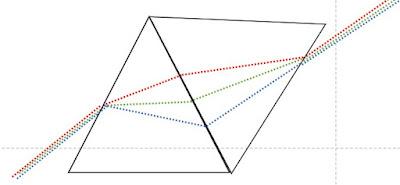Follow up to this post to illustrate the contradictions.
Light going through a pane is easy enough. All colours are bent by the same amount on entering and on leaving, and what goes in = what goes out, which is parallel to the original ray. We also know that light takes the fastest route from source to image (like the "dog crossing a canal diagonally to chase prey some way from the canal bank" problem in maths):
 Light going through a prism is easy enough as well. For some reason, longer wavelengths (red) are bent less than shorter ones (blue). You can read this one in either direction - either white light source on left being split into colours, or different colours coming in from the right to merge to white light on the way out (left):
Light going through a prism is easy enough as well. For some reason, longer wavelengths (red) are bent less than shorter ones (blue). You can read this one in either direction - either white light source on left being split into colours, or different colours coming in from the right to merge to white light on the way out (left):
 If you add a second prism flipped upside down with a gap between them, the second prism reverses everything back into a single white beam on the way out - the two prisms act much like a single pane with an air gap in it.
If you add a second prism flipped upside down with a gap between them, the second prism reverses everything back into a single white beam on the way out - the two prisms act much like a single pane with an air gap in it.
But what if the two prisms are polished so perfectly that they are flat on a molecular level, and you move the two prisms closer and closer together until they are 100% touching (forming a single pane). We know what goes in, we know what comes out.
- Do the different colours take different paths (as shown in my rather badly drawn picture below), or do they "realise" that they are being tricked and "decide" that they are actually dealing with a single pane and then all follow the same path (as in the first picture)?
- They can't "know" what to do on entering until they leave again. Or does the fact that light, in its own reference frame, travels instantaneously (if something is traveling at the speed of light, then time slows to zero), play a part here?
- The assumption that they all take the fastest route (in our frame of reference) from source to image breaks down, as the red light (being least bent) must have traveled a shorter distance through the glass than green and blue.
- Or, as I asked last time, is there some mysterious quantum mechanics effect happening on the tiniest level incomprehensible to humans, which means that each photon takes every possible path, has a "think" when it's got there and then "chooses" the best one?

